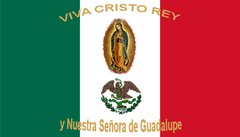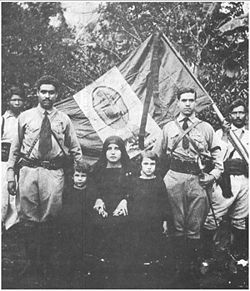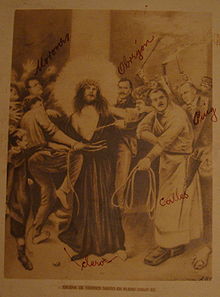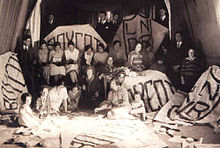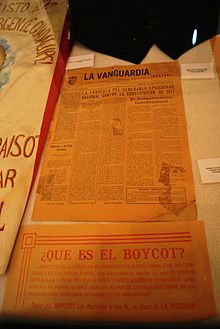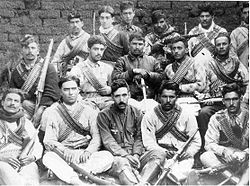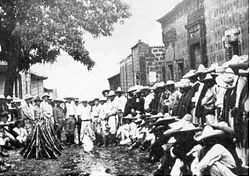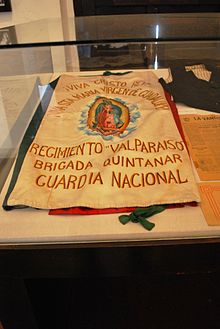
Cristero War
About this schools Wikipedia selection
This content from Wikipedia has been selected by SOS Children for suitability in schools around the world. A quick link for child sponsorship is http://www.sponsor-a-child.org.uk/
| Cristero War | |
|---|---|
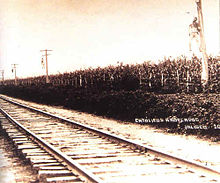 Mexican government forces publicly hanged Cristero rebels on telegraph poles in Jalisco, Mexico. The tactic was used throughout the war, with bodies often remaining on the poles until the pueblo or town renounced public religious practice. |
|
| Participants | Mexican federal government, Mexican rebels |
| Location | Mexico |
| Date | 1926–1929 |
| Result | Years of persecution of Mexican Catholics and the Catholic Church in Mexico |
| History of Mexico |
|---|
 |
|
Pre-Columbian
|
|
Spanish rule
|
|
First Republic
|
|
Second Federal Republic
|
|
1864 – 1928
|
|
Modern
|
| Timeline |
The Cristero War (1926–29) also known as La Cristiada, was a mass popular uprising and attempted counter-revolution against the anti-Catholicism of the ruling Mexican government. Based in western Mexico, the rebellion was set off by the enforcement of the Mexican Constitution of 1917 by former Mexican President and atheist Plutarco Elías Calles, in order to persecute the Roman Catholic Church and its sub-organizations - a move inspired by Calles' atheism.
The Mexican Revolution was the largest rebellion in Mexican history. It was based on the peasants' overwhelming demand for land and for social justice. The Catholic Church was cautious to not support the revolution, which at times threatened the property rights of many Mexicans. However, the Calles' administration felt its revolutionary reforms regarding private property, public education, and social reform were threatened by the Church. As a solution to the Church's influence over the Mexican populace, the anti-clerical statutes of the Constitution were instituted, and beginning a 10 year persecution of Catholics, resulting in the death of thousands.
After a period of peaceful resistance by Mexican citizens, a number of skirmishes took place in 1926; violent rebellions began in 1927. The rebels called themselves Cristeros, invoking the name of Jesus Christ under the title of "Cristo Rey" or Christ the King. The rebellion is known for the women who assisted the rebels in smuggling guns and ammunition and for certain priests who were tortured and murdered in public and later canonized by Pope John Paul II. The rebellion eventually ended by diplomatic means brokered by the United States Ambassador to Mexico, Dwight Whitney Morrow, with the financial relief and assistance by the Knights of Columbus.
The rebellion attracted the attention of Pope Pius XI, who issued a series of papal encyclicals between 1925 and 1937. On 11 December 1925 the pontiff issued Quas Primas, instituting the Feast of Christ the King. On November 18, 1926, he issued Iniquis Afflictisque (On the Persecution of the Church in Mexico) denouncing the violent anti-clerical persecution in Mexico. Despite the government's promise to the Church, it continued the persecution of the Church and the people. In response, Pope Pius issued Acerba Animi on September 29, 1932. As the persecution continued he issued Firmissimam Constantiam and expressed his opposition to the "impious and corruptive school" (p. 22) while granting papal support for Catholic Action in Mexico for the third consecutive time with the use of plenary indulgence on 28 March 1937.
The Mexican Constitution of 1917
The Political Constitution of the United Mexican States was redacted by the Constitutional Congress convoked by Venustiano Carranza in September 1916, and it was approved on 5 February 1917. The new constitution was based in the previous one instituted by Benito Juárez in 1857. Three of its 136 articles—3, 27 and 130—contain heavily secularizing sections.
The first two sections of article 3 state: I. According to the religious liberties established under article 24, educational services shall be secular and, therefore, free of any religious orientation. II. The educational services shall be based on scientific progress and shall fight against ignorance, ignorance's effects, servitudes, fanaticism and prejudice. The second section of article 27 states that: All religious associations organized according to article 130 and its derived legislation, shall be authorized to acquire, possess or manage just the necessary assets to achieve their objectives.
The first paragraph of article 130 states that: The rules established at this article are guided by the historical principle according to which the State and the churches are separated entities from each other. Churches and religious congregations shall be organized under the law.
It also provided for obligatory state registration of all churches and religious congregations, and placed a series of restrictions on priests and ministers of all religions (ineligible to hold public office, to canvas on behalf of political parties or candidates, to inherit from persons other than close blood relatives, etc.). The article also allowed the state to regulate the number of priests in each region—even reducing the number to zero—forbade the wearing of religious garb and excluded offenders from a trial by jury. Venustiano Carranza declared himself opposed to the final redaction of Articles 3, 5, 24, 27, 123 and 130, but the Constitutional Congress contained only 85 conservatives and centrists close to Carranza's rather restrictive brand of 'liberalism'; against them were 132 more radical delegates.
Article 24 states that: "Every man shall be free to choose and profess any religious belief as long as it is lawful and it cannot be punished under criminal law. The Congress shall not be authorized to enact laws either establishing or prohibiting a particular religion. Religious ceremonies of public nature shall be ordinarily performed at the temples. Those performed outdoors shall be regulated under the law.
Background to rebellion
There was violence on a limited scale throughout the early 1920s. In 1926, following passage of stringent anti-clerical criminal laws and enforcement of these so-called Calles Laws (named for President of Mexico Plutarco Elías Calles) coupled with farmer's revolts against land reform in the heavily Catholic Bajio, scattered guerrilla operations coalesced into a serious armed revolt against the government. Catholic and anti-clerical groups turned to terrorism. Of the several uprisings against the Mexican government in the 1920s, the Cristero War was the most devastating, and had the most long-range effects. It was largely resolved both through military defeat of the guerrilla army headed by Enrique Gorostieta Velarde and a diplomatic settlement by 1929. However, persecution of Catholics and anti-government terrorist attacks continued into the 1940s, when the remaining organized Cristero groups were incorporated into the Synarchist Party.
The Mexican Revolution of 1910 was originally fought against longtime autocrat Porfirio Díaz, and in favour of the demand by the mass of peasantry for land. However, the late revolutionary leader Plutarco Elias Calles took radically anti-Catholic stances, inspired by his freemasonry, despite the Church's overwhelming support by the people. Francisco I. Madero was the first revolutionary leader. Madero was elected president in November 1911, but was eventually overthrown and executed in 1913 by the counterrevolutionary Victoriano Huerta. When General Huerta seized power after Madero's assassination, Archbishop Ruiz y Flores from Morelia published a letter condemning the coup and distanced the Church from Huerta. The National Catholic Party newspaper, representing the views of the bishops, attacked Huerta severely and, as a result, the new regime jailed the President of the NCP and halted the publication of the newspaper. Nevertheless, some members of the National Catholic Party decided to participate in Huerta's regime, like Eduardo Tamariz. The revolutionary generals Carranza, Villa and Zapata, who vanquished Huerta's federal army under the Plan of Guadalupe, had friendships with the Catholics and local parish priests that collaborated with them, but they also blame the High Catholic Clergy for supporting Huerta.
Carranza was the first president under the new Constitution, but he was overthrown by one-time ally Álvaro Obregón in 1919, who succeeded to the presidency in late 1920. Obregón effectively applied the secularist laws emanating from the constitution, only in areas where Catholic sentiment was weakest. This uneasy "truce" between the government and the Church ended with the 1924 hand-picked succession of an atheist, Plutarco Elías Calles. Mexican Jacobins, supported by Calles's central government, went beyond mere anticlericalism and engaged in secular antireligious campaigns to eradicate what they called "superstition" and "fanaticism", including desecration of religious objects, persecution, and murder, of the clergy and anticlerical legislation.
Calles applied the anti-clerical laws stringently throughout the country and added his own anti-clerical legislation. In June 1926 he signed the "Law for Reforming the Penal Code", known unofficially as the " Calles Law". This provided specific penalties for priests and individuals who violated the provisions of the 1917 Constitution. For instance, wearing clerical garb in public (i.e., outside Church buildings) earned a fine of 500 pesos (approximately $250 US at the time); a priest who criticized the government could be imprisoned for five years. Some states enacted oppressive measures. Chihuahua enacted a law permitting only a single priest to serve the entire Catholic congregation of the state. To help enforce the law, Calles seized church property, expelled all foreign priests, and closed the monasteries, convents and religious schools.
Peaceful resistance
In response to these measures, Catholic organizations began to intensify their resistance. The most important of these groups was the National League for the Defense of Religious Liberty, founded in 1924. This was joined by the Mexican Association of Catholic Youth (founded 1913) and the Popular Union, a Catholic political party founded in 1925. On 11 July 1926, Catholic bishops voted to suspend all public worship in response to the Calles Law. This suspension was to take effect on 1 August. On 14 July they endorsed plans for an economic boycott against the government, which was particularly effective in west-central Mexico (the states of Jalisco, Guanajuato, Aguascalientes, and Zacatecas). Catholics in these areas stopped attending movies and plays and using public transportation, and Catholic teachers stopped teaching in secular schools.
The bishops worked to have the offending articles of the Constitution amended. Pope Pius XI explicitly approved this plan. The Calles government considered the bishops' activism sedition and had many more churches closed. In September the episcopate submitted a proposal for the amendment of the constitution, but Congress rejected it on 22 September 1926.
Escalation of violence
In Guadalajara, Jalisco, on 3 August 1926, some 400 armed Catholics shut themselves up in the Church of Our Lady of Guadalupe. They were involved in a shootout with federal troops and surrendered only when they ran out of ammunition. According to U.S. consular sources, this battle resulted in 18 dead and 40 wounded. The following day, in Sahuayo, Michoacán, 240 government soldiers stormed the parish church. The priest and his vicar were killed in the ensuing violence. On 14 August government agents staged a purge of the Chalchihuites, Zacatecas, chapter of the Association of Catholic Youth and executed their spiritual adviser, Father Luis Bátiz Sainz. This execution caused a band of ranchers, led by Pedro Quintanar, to seize the local treasury and declare themselves in rebellion. At the height of their rebellion they held a region including the entire northern part of Jalisco. Luis Navarro Origel, the mayor of Pénjamo, Guanajuato, led another uprising on 28 September. His men were defeated by federal troops in the open land around the town but retreated into the mountains, where they continued as guerrillas.
This was followed by an uprising in Durango led by Trinidad Mora on 29 September, and a 4 October rebellion in southern Guanajuato, led by former Gen. Rodolfo Gallegos. Both of these rebel leaders adopted guerrilla tactics, as they were no match for the federal troops and air force on open ground. Meanwhile, the rebels in Jalisco (particularly the region northeast of Guadalajara) quietly began gathering forces. This region became the main focal point of the rebellion, led by 27-year-old René Capistrán Garza, leader of the Mexican Association of Catholic Youth.
Cristero War
The formal rebellion began on 1 January 1927 with a manifesto sent by Garza on New Year's Day, titled A la Nación (To the Nation). This declared that "the hour of battle has sounded" and "the hour of victory belongs to God". With the declaration, the state of Jalisco, which had seemed to be quiet since the Guadalajara church uprising, exploded. Bands of rebels moving in the " Los Altos" region northeast of Guadalajara began seizing villages, often armed with only ancient muskets and clubs. The Cristeros' battle cry was ¡Viva Cristo Rey! ¡Viva la Virgen de Guadalupe! (Long live Christ the King! Long live the Virgin of Guadalupe!). The rebels had scarce logistical supplies and relied heavily on the Feminine Brigades of St. Joan of Arc, raids on towns, trains and ranches in order to supply themselves with money, horses, ammunition and food. By contrast, later in the war the Calles government was supplied with arms and ammunition by the US government. In at least one battle, American pilots provided air support for the federal army against the Cristero rebels.
The Calles government did not take the threat seriously at first. The rebels did well against the agraristas (a rural militia recruited throughout Mexico) and the Social Defense forces (local militia), but—at first—were always defeated by the federal troops who guarded the important cities. At this time the federal army numbered 79,759 men. When Jalisco federal commander Gen. Jesús Ferreira moved on the rebels, he matter-of-factly wired to army headquarters that "it will be less a campaign than a hunt." It was a sentiment that Calles also held.
However, these rebels, who had little or no previous military experience for the most part, planned their battles well. The most successful rebel leaders were Jesús Degollado (a pharmacist), Victoriano Ramírez (a ranch hand) and two priests, Aristeo Pedroza and José Reyes Vega. Reyes Vega was renowned and Cardinal Davila, deemed him a "black-hearted assassin". At least five priests took up arms, while many others supported them in various ways.
The Mexican episcopate never officially supported the rebellion, but the rebels had some indications that their cause was legitimate. Bishop José Francisco Orozco of Guadalajara remained with the rebels; while formally rejecting armed rebellion, he was unwilling to leave his flock.
On 23 February 1927, the Cristeros defeated federal troops for the first time at San Francisco del Rincón, Guanajuato, followed by another victory at San Julián, Jalisco. However, they quickly began to lose in the face of superior federal forces, and retreated into remote areas, constantly fleeing federal soldiers. Most of the leadership of the revolt in the state of Jalisco was forced to flee to the United States, although Victoriano Ramírez and Fr. Reyes Vega remained. In April the leader of the civilian wing of the Cristiada, Anacleto González Flores, was captured, tortured and killed. The media and government declared victory and plans were made for a re-education campaign in the areas that had rebelled. As if to prove that the rebellion was not extinguished, and to avenge the death of González Flores, Father Reyes Vega led a raid against a train carrying a shipment of money for the Bank of Mexico on 19 April. The raid was a success, but Reyes Vega's brother was killed in the fighting.
The "concentration" policy, rather than suppressing the revolt, gave it new life, as thousands of men began to aid and join the rebels in resentment of the cruel treatment of the Federation. When the rains came the peasants were allowed to return to the harvest, and there was now more support than ever for the Cristeros. By August they had consolidated their movement and were constantly attacking federal troops garrisoned in their towns. Soon they would be joined by Enrique Gorostieta, a retired general hired by the National League for Religious Liberty. Although Gorostieta was himself a liberal and a skeptic, he would eventually wear a cross around his neck and speak openly of his reliance on God.
Fathers Reyes Vega and Pedroza were born soldiers. Pedroza was rigidly moral and faithful to his priestly vows. However, the fact that the two took up arms at all is problematic from the point of view of Catholic sacramental theology. On 21 June 1927 the first brigade of female Cristeros was formed in Zapopan. They named themselves for Saint Joan of Arc: the Feminine Brigades of St. Joan of Arc. The brigade began with 17 women, but soon grew to 135 members. Its mission was to obtain money, weapons, provisions and information for the combatant men; they also cared for the wounded. By March 1928 there were some 10,000 women involved. Many smuggled weapons into the combat zones by carrying them in carts filled with grain or cement. By the end of the war, they numbered some 25,000.
The de la Torre family, who had close ties to the Catholic Church and clergy, was instrumental in bringing the Cristero Movement to northern Mexico. The family, originally from Zacatecas and Guanajuato, moved to Aguascalientes and then in 1922 to San Luis Potosí. They moved again to Tampico for economic reasons and finally to Nogales—both the Mexican city and its similarly named sister city across the border in Arizona—to escape persecution from authorities because of their involvement in the Church and the movement
The Cristeros maintained the upper hand throughout 1928, and in 1929 the federal government faced a new crisis: a revolt within army ranks, led by Arnulfo R. Gómez in Veracruz. The Cristeros tried to take advantage of this with an attack on Guadalajara in late March. It failed, but the rebels did manage to take Tepatitlán on April 19. Father Vega was killed in that battle. The military rebellion was met with equal force and the Cristeros were soon facing divisions within their own ranks. On 2 June Gorostieta was killed in an ambush by a federal patrol. However, the rebels had some 50,000 men under arms by this point and seemed poised to draw out the rebellion for a long time.
Diplomacy and the uprising
In October 1927 the U.S. ambassador to Mexico was Dwight Whitney Morrow. He initiated a series of breakfast meetings with President Calles at which the two would discuss a range of issues, from the religious uprising to oil and irrigation. This earned him the nickname "the ham and eggs diplomat" in U.S. papers. Morrow wanted the conflict to end both for regional security and to help find a solution to the oil problem in the US. He was aided in his efforts by Father John J. Burke of the National Catholic Welfare Conference. Calles' term as president was coming to an end—former president Álvaro Obregón had been elected president and was scheduled to take office on 1 December 1928. Though Obregon had been more lenient to Catholics during his time in office, it was also greatly accepted among Mexicans—including the Cristeros—that Calles was his puppet leader. Two weeks after his election, Obregón was assassinated by a Catholic radical, José de León Toral, an event that gravely damaged the peace process.
Congress named Emilio Portes Gil interim president in September 1928, with an election to be held in November 1929. Portes was more open to the Church than Calles had been, allowing Morrow and Burke to re-initiate the peace initiative. Portes told a foreign correspondent on May 1 that "the Catholic clergy, when they wish, may renew the exercise of their rites with only one obligation, that they respect the laws of the land". The next day, exiled Archbishop Leopoldo Ruíz y Flores issued a statement that the bishops would not demand the repeal of the laws, only their more lenient application. Morrow managed to bring the parties to agreement on 21 June 1929. His office drafted a pact called the arreglos (agreement) that allowed worship to resume in Mexico and granted three concessions to the Catholics: only priests who were named by hierarchical superiors would be required to register, religious instruction in the churches (but not in the schools) would be permitted, and all citizens, including the clergy, would be allowed to make petitions to reform the laws. But the most important part of the agreement was that the church would recover the right to use its properties, and priests recovered their rights to live on such property. Legally speaking, the church was not allowed to own real estate, and its former facilities remained federal property. However, the church effectively took control over the properties. It was a convenient arrangement for both parties, and the church ostensibly ended its support for the rebels.
Over the previous two years, anticlerical officers who were hostile to the federal government for reasons other than its position on religion had joined the rebels. When the agreement between the government and the church was made known, only a minority of the rebels went home, mainly those who felt their battle had been won. On the other hand, since the rebels themselves were not consulted in the talks, many felt betrayed and some continued to fight. The church threatened those rebels with excommunication, and gradually the rebellion died out. The officers, fearing that they would be tried as traitors, tried to keep the rebellion alive. This attempt failed and many were captured and shot, while others escaped to San Luis Potosí, where Gen. Saturnino Cedillo gave them refuge.
On 27 June 1929, the church bells rang in Mexico for the first time in almost three years. The war had claimed the lives of some 90,000 people: 56,882 on the federal side, 30,000 Cristeros, and numerous civilians and Cristeros who were killed in anticlerical raids after the war ended. As promised by Portes Gil, the Calles Law remained on the books, but no organized federal attempts to enforce it took place. Nonetheless, in several localities, officials continued persecution of Catholic priests based on their interpretation of the law. In 1992, the Mexican government amended the constitution by granting all religious groups legal status, conceding them limited property rights and lifting restrictions on the number of priests in the country.
Present-day
The Mexican constitution prohibits outdoor worship, which is only allowed in exceptional circumstances, generally requiring governmental permission. Religious organizations are not permitted to own print or electronic media outlets, governmental permission is required to broadcast religious ceremonies, and ministers are prohibited from being political candidates or holding public office. Despite remnants of anti-clerical statutes, there is no real enforcement of them, and the Catholic Church enjoys overwhelming liberties from the Government, as well as devotion from the people.
Aftermath of the war and the toll on the Church
The government in many cases did not abide by the terms of the truce and, in violation of its terms, executed some 500 Cristero leaders and 5,000 other Cristeros. Particularly offensive to Catholics after the supposed truce was Calles' insistence on a complete state monopoly on education, suppressing all Catholic education and introducing secular education in its place: "We must enter and take possession of the mind of childhood, the mind of youth." Calles' military persecution of Catholics would be officially condemned by left-socialist leaning President Lázaro Cárdenas and the Mexican Congress in 1935. Between 1935 and 1936 Cardenas had Calles and many of his close associates arrested and forced them into exile soon afterwards. Freedom of worship was no longer suppressed, although some states still refused to repeal Calles' policy, and relations with the church improved while Cardenas was president.
Government disregard for the church, however, did not relent until 1940, when President Manuel Ávila Camacho, a practicing Catholic, took office. Church buildings in the country still belonged to the Mexican government and the nation's policies regarding the church still fell into federal jurisdiction. Under Camacho, the bans against church, though lawfully required either throughout the country or in just some Mexican states, were no longer enforced anywhere in Mexico.
The effects of the war on the Church were profound. Between 1926 and 1934 at least 40 priests were killed. There were 4,500 priests serving the people before the rebellion, but by 1934 there were only 334 licensed by the government to serve 15 million people. The rest had been eliminated by emigration, expulsion and assassination. By 1935, 17 states had no priests at all.
The end of the Cristero War affected emigration to the United States. "In the aftermath of their defeat, many of the Cristeros--by some estimates as much as 5 percent of Mexico's population--fled to America [i.e. the United States]. Many of them made their way to Los Angeles, where they found a protector in John Joseph Cantwell, the bishop of what was then the Los Angeles-San Diego diocese." Under Archbishop Cantwell's sponsorship the Cristero refugees became a substantial community in Los Angeles, in 1934 staging a parade some 40,000 strong through the city.
Cristero War saints
The Catholic Church has recognized several of those killed in the Cristero rebellion as martyrs, including the Blessed Miguel Pro ( SJ), who was executed by firing squad on 23 November 1927—without a trial—on trumped-up charges of involvement in an assassination attempt against former President Álvaro Obregón but in actuality for his priestly activities in defiance of the government. His beatification occurred in 1988.
On 21 May 2000, Pope John Paul II canonized a group of 25 martyrs from this period. They had been beatified on 22 November 1992. Of this group, 22 were secular clergy and three were laymen. They did not take up arms but refused to leave their flocks and ministries, being shot or hanged by government forces for offering the sacraments. Most were executed by federal forces. Although Pedro de Jesús Maldonado was killed in 1937, after the war ended, he is considered a Cristero and a member of this group .
Father Luis Bátiz Sainz was the parish priest in Chalchihuites and a member of the Knights of Columbus. He was known for his devotion to the Eucharist and for his prayer for martyrdom: "Lord, I want to be a martyr; even though I am your unworthy servant, I want to pour out my blood, drop by drop, for your name." In 1926, shortly before the closing of the churches, he was denounced as a conspirator against the government because of his connections with the National League for the Defense of Religious Liberty, which was preparing an armed uprising. A squad of soldiers raided the private house where he was staying on August 14 and took him captive. They executed him, reportedly without benefit of a trial, along with three youths of the Mexican Association of Catholic Youth.
The Catholic Church declared 13 additional victims of the anti-Catholic regime as martyrs on 20 November 2005, thus paving the way for their beatifications. This group was mostly lay people, including a 14-year-old, José Sánchez del Río. On 20 November 2005, at Jalisco Stadium in Guadalajara, José Saraiva Cardinal Martins celebrated the beatifications.
Socialist education and incidents against rural teachers
As it was mentioned above, the Calles law was repealed after Lázaro Cárdenas became president. Cárdenas earned respect from Pope Pius and befriended Mexican Archbishop Luis María Martinez, a major figure in Mexico's Catholic Church who successfully persuaded Mexicans to obey the government's laws in a peaceful manner. The church refused to back Mexican insurgent Saturnino Cedillo's failed revolt against Cardenas, despite the fact that Cedillo endorsed more freedom for the church as well.
Cardenas' government continued to suppress religion in the field of education during his administration (1934–40). Congress amended Article 3 of the Constitution in October 1934 to include the following introductory text (textual translation): "The education imparted by the State shall be a socialist one and, in addition to excluding all religious doctrine, shall combat fanaticism and prejudices by organizing its instruction and activities in a way that shall permit the creation in youth of an exact and rational concept of the Universe and of social life." This amendment was invalidated by future President Manuel Ávila Camacho and was officially repealed from the Mexican Constitution in 1946. Constitutional bans against the church would not be enforced anywhere in Mexico during Camacho's presidency.
The promotion of socialist education met with strong opposition in some parts of academia and in areas formerly controlled by the Cristeros.
Pope Pius XI also published the encyclical Firmissimam Constantiam on 28 March 1937, expressing his opposition to the "impious and corruptive school" (paragraph 22) and his support for Catholic Action in Mexico. This was the third and last encyclical published by Pius XI making reference to the religious situation in Mexico.
Many of those formerly associated with the Cristeros took up arms again as independent rebels, and they were followed by some other Catholics, but this time unarmed teachers were among the main targets of independent rebel-associated atrocities. Government supporters blame these on the Cristero movement in general.
Rural teachers did not take up arms, but some of them refused to leave their schools and communities, and many had their ears cut off. This is the reason why those teachers who were murdered and had their corpses desecrated are often known as maestros desorejados ("teachers without ears") in Mexico.
In some of the worst cases, teachers were tortured and murdered by the former Cristero rebels. It is calculated that almost 300 rural teachers were murdered in this way between 1935 and 1939, while other authors calculate that at least 223 teachers were victims of the violence between 1931 and 1940, including the assassinations of Carlos Sayago, Carlos Pastraña and Librado Labastida in Teziutlán, Puebla, hometown of future president Manuel Ávila Camacho; the execution of a teacher, Carlos Toledano, who was burned alive in Tlapacoyan, Veracruz; and the lynching of at least 42 teachers in the state of Michoacán: J. Trinidad Ramírez in Contepec, Pedro García in Apatzingan, Juan Gonzalez Valdespino in Huajumbaro, José Rivera Romero in Ciudad Hidalgo, María Salud Morales in Tacambaro; et al. The atrocities by the rebels and associated Catholics against rural teachers have been criticized in essays and books published by the Ibero-American University in Mexico, a college run by the Jesuit order of the Catholic Church.
Knights of Columbus Involvement
Both American councils and mostly newly formed Mexican councils of the Knights of Columbus opposed the persecution by the Mexican state. To date, nine of those beatified or canonized were Knights. The American Knights collected more than a million dollars to assist exiles from Mexico, to continue the education of expelled seminarians, and to inform citizens of the U.S. about oppression. They circulated five million leaflets educating the U.S. about the war, held hundreds of lectures and spread the news via radio. In addition to fostering an informed public the order met with Calvin Coolidge to press for intervention in the oppression in Mexico.
In Mexico, according to Supreme Knight of Knights of Columbus Carl A. Anderson, two thirds of their Mexican Catholic councils were shut down by the Mexican government at the time. In response, the Knights of Columbus published posters and magazines placing the Cristero soldiers in positive light.
Ku Klux Klan Involvement
High-ranking members of the U.S. Ku Klux Klan in the mid-1920s offered Calles $10,000 to help fight the Church. The offer came when the Knights of Columbus secretly offered a group of Cristero rebels $1,000 of financial assistance for guns and ammunition. This was made after the fact that Calles also sent a private telegram to the Mexican Ambassador to France, Sr. Alberto José Pani Arteaga advising that the "...Catholic Church in Mexico is a political movement, and must be eliminated in order to proceed with a Socialist government free of religious hypnotism which fools the people... within one year without the sacraments, the people will forget the faith..."
Battle hymn of the Cristeros
A surviving Cristero, Juan Gutiérrez, recited a hymn sung by the Cristeros, to the tune of the Spanish " Marcha Real."
- Spanish
- La Virgen María es nuestra protectora y nuestra defensora cuando hay que temer
- Vencerá a todo el demonio gritando "¡Viva Cristo Rey!" (x2)
- Soldados de Cristo: ¡Sigamos la bandera, que la cruz enseña el ejército de Dios!
- Sigamos la bandera gritando, "¡Viva Cristo Rey!"
- English translation
- The Virgin Mary is our protector and defender when we have to fear
- She will vanquish all demons with a cry of "Long live Christ the King!" (x2)
- Soldiers of Christ, let us follow this flag, for its cross points to the army of God
- Let us follow the flag and declare, "Long live Christ the King!"
Other views
French historian and researcher Jean Meyer argues that the Cristero soldiers were western peasants who tried to resist the heavy pressures of the modern bourgeois state and its Revolution, of the city elites, and of the rich, all of whom wanted to suppress the Roman Catholic faith.
In popular culture
Juan Rulfo's famous novel Pedro Páramo is set during the Cristero War in northwestern Mexico.
Graham Greene's novel The Power and the Glory is set during this period.
There is a long section of B. Traven's novel The Treasure of the Sierra Madre devoted to the history of what Traven refers to as "the Christian Bandits". However, in the classic film made from the novel, no mention is made of the Cristeros, although the novel takes place in the same time period as the rebellion.
The film For Greater Glory came out in 2012, displaying the struggles and victories of several key figures in the Cristero War.
Many fact-based films, shorts and documentaries about the war have been produced since 1929. The list includes:
- El coloso de mármol (1929)
- Los cristeros (aka Sucedió en Jalisco) (1947)
- La guerra santa (1979)
- La cristiada (1986)
- Cristeros y federales (2011)
- Los últimos cristeros (aka The Last Christeros) (2011)
- Cristiada (aka For Greater Glory) (1 June 2012 release date)
